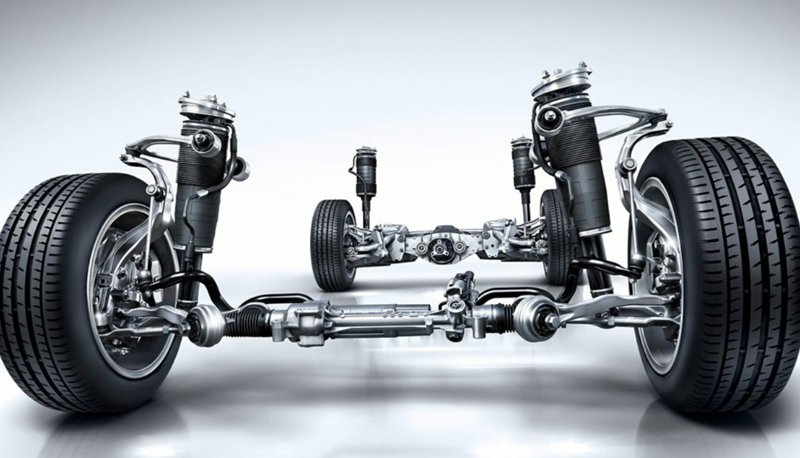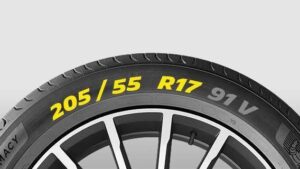Ever wonder why your car doesn’t bounce like a trampoline when you hit a pothole? Or why does it stay level even when you slam on the brakes? That’s all thanks to your suspension system—a crucial yet often overlooked part of your car.
As a mechanic, I see plenty of customers with suspension issues, but most don’t know much about how it works. That’s why I’m breaking it down for you in simple terms. By the time you finish this guide, you’ll understand what your suspension does, how to spot trouble, and how to keep it in good shape. Let’s get rolling!
What Your Suspension Actually Does
Think of your suspension as your car’s legs, and just like your legs do for your body, It smooths out bumps, keeps your tyres in contact with the road, and ensures your ride stays stable when turning, accelerating, or braking.
Without it, driving would feel like a rollercoaster—fun for about 10 seconds, then downright terrifying.
Your suspension does three key things:
- Absorbs impact from potholes, bumps, and rough roads.
- Keeps the tyres planted on the pavement for better grip and control.
- Maintains balance so your car doesn’t lean too much in turns or nosedive when you brake.
A healthy suspension makes for a smooth, safe, and controlled ride.
Meet the Suspension Team: Key Components
Your suspension is a team effort. Each part plays a role in keeping things stable and comfortable. Here’s a quick rundown of the main players:
1. Springs
Springs do the heavy lifting, absorbing energy from bumps and keeping your car at the right height. There are three main types:
- Coil Springs: Most common, found in regular cars.
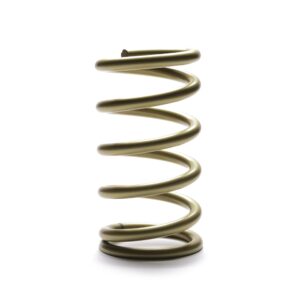
Coil springs - Leaf Springs: Heavy-duty, used in trucks and older cars.
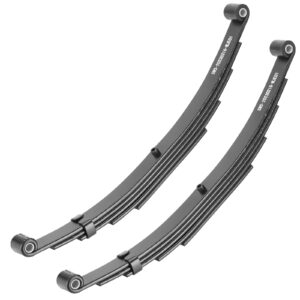
Leaf Springs - Torsion Bars: Twist instead of compress, used in some SUVs and off-road vehicles.

Torsion bar (blue)
2. Shock Absorbers (Shocks)
If you’ve ever bounced on a trampoline, you know springs alone don’t stop motion. That’s where shocks come in. They dampen excessive bouncing, so your car doesn’t keep bobbing after every bump.
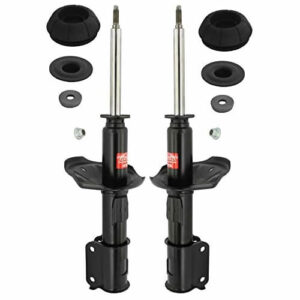
3. Struts
Struts are like a combo meal—shocks and springs in one unit. They’re common in front-wheel-drive cars and help support the car’s weight while absorbing shocks.

4. Control Arms
These connect your wheels to the frame, allowing controlled up-and-down movement while keeping the wheels aligned.
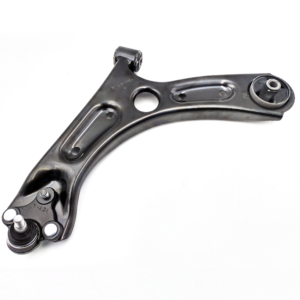
5. Sway Bars (Stabilizer Bars)
Ever notice how a car leans when taking a sharp turn? Sway bars help prevent that by linking both sides of the suspension, improving stability and handling.
All these parts work together to keep your ride smooth and safe.
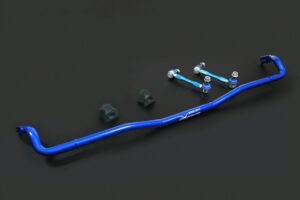 U
U
How Suspension Works in Different Driving Conditions
Your suspension isn’t just there for comfort—it actively adjusts to road conditions. Here’s how:
- On smooth roads: The system remains stable, with minimal compression.
- On bumpy roads: Springs absorb impact, and shocks keep bouncing in check.
- During sharp turns: Sway bars and control arms help reduce body roll, so you don’t feel like you’re tipping over.
- When braking or accelerating: The suspension keeps your car level, preventing excessive nosediving or squatting.
It’s constantly working to give you the best ride possible.
Signs Your Suspension Needs Attention
Suspension issues sneak up on you. One day your ride is smooth, and the next, it feels like you’re driving a go-kart on a gravel road. Here are some red flags:
- Your car bounces too much. If it keeps bouncing after hitting a bump, your shocks or struts might be worn out.
- Uneven tyre wear. A bad suspension can throw off wheel alignment, causing uneven tread wear.
- Drifting or pulling in turns. If your car leans too much, your sway bar or shocks could be the problem.
- Nosediving when braking. If the front dips too much when you hit the brakes, your suspension might be worn out.
- Leaking fluid on shocks or struts. If you see oil dripping from these parts, they need replacing.
- Noise and vibration from the wheel area: If your vehicle starts shaking/ vibrating when you drive on rough surfaces, or during acceleration and braking, your suspension might be worn.
Ignoring these warning signs can make your car harder to handle—and a lot less safe.
Different Types of Suspension Systems
Not all cars have the same suspension setup. Here’s a quick breakdown of the most common types:
1. Solid Axle Suspension
Used in trucks and older cars, this setup connects both wheels with a rigid axle—stronger, but less comfortable.
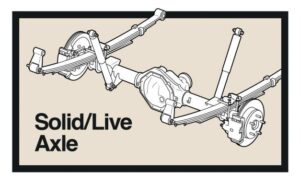
Independent Suspension
Each wheel moves independently, improving comfort and handling. Most modern cars use this design.
2. MacPherson Strut Suspension
A simple, affordable design, commonly found in front-wheel-drive cars.
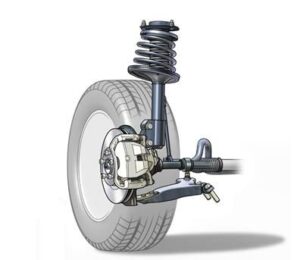

3. Multi-Link Suspension
Found in high-performance and luxury cars, offering the best balance of comfort and handling.
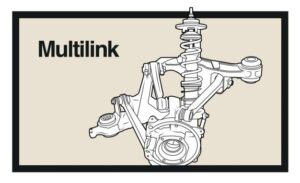
4. Double Wishbone Suspension
The double wishbone suspension features two A-shaped control arms per wheel, enhancing handling, stability, and comfort. It provides better tyre contact, reduces body roll, and allows precise alignment adjustments. However, it’s complex, costly, and requires more space, making it common in high-performance vehicles.
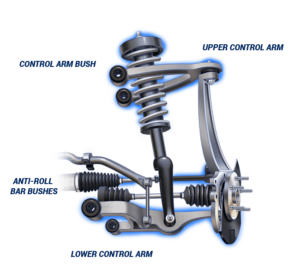
Knowing what type of suspension your car has can help you diagnose issues and make informed repair decisions.
How to Keep Your Suspension in Top Shape
You don’t need to be a mechanic to take care of your suspension. A few simple checks and routine maintenance can keep it running smoothly.
Regular Checks
- Look at your tyres. Uneven wear could mean suspension problems.
- Listen for weird noises. Clunks, squeaks, or rattles usually mean something’s loose or worn.
- Do the bounce test. Push down on the hood or trunk. If your car bounces more than twice, your shocks might be shot.
When to Replace Parts
- Shocks & Struts: Every 50,000–100,000 miles, depending on road conditions.
- Control Arms & Bushings: If they become loose or worn, affecting steering response.
- Springs: Rarely need replacing unless they break or sag.
- Sway Bars & Links: If your car feels too wobbly in turn, these might need attention.
Keeping up with maintenance extends the life of your suspension and keeps your ride smooth.
When to See a Mechanic
Some suspension issues are DIY-friendly, but others need a professional touch. Head to a mechanic if:
- Your car suddenly feels hard to control.
- You hear loud clunking or knocking sounds.
- One side of your car sits lower than the other.
- There’s fluid leaking from your shocks or struts.
A mechanic has the tools and expertise to diagnose and fix suspension problems quickly and safely.
My Final Thoughts
Your suspension system does more than just keep your ride comfortable—it plays a major role in safety and handling. Understanding how it works helps you spot issues early and keep it in top shape.
So next time your car feels off, you won’t just shrug it off—you’ll have a better idea of what’s happening underneath. And if in doubt, a quick visit to a mechanic can save you from bigger, costlier problems down the road.
Drive safe, and keep your suspension in check!

